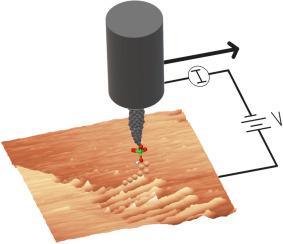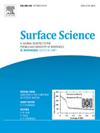空气中 STM 观察金(111)表面扰动,包括溶剂选择改变的金魔指
IF 2.1
4区 化学
Q3 CHEMISTRY, PHYSICAL
引用次数: 0
摘要
金(111)表面现象中被广泛研究的一种是金魔指的形成,这种现象在近 20 年前首次被发现。观测金魔指形成的实验条件多种多样,但人们更倾向于超高真空和低温研究。随着扫描探针技术的发展,我们有可能在包括空气和室温在内的更多相关条件下研究这些独特的结构。在暴露于 0.1 M 溶剂溶液后,Au(111) 显示出三种类型的表面扰动,包括根据溶剂特性形成的金魔指。扰动类型取决于溶剂分子的特性,特别是其总电荷及其在水环境中的电解行为。扰动机理依赖于针尖与表面的强烈相互作用以及金原子的质量传输,而所选溶剂则改变了这一机理。总之,能够在超高真空以外的环境中以重复的方式形成有组织的纳米结构(如金魔指),并且不需要保护液层,这提高了这些结构在更广泛领域和应用领域的实用性。本文章由计算机程序翻译,如有差异,请以英文原文为准。

In air STM observation of Au(111) surface disturbance including Au magic fingers as modified by solvent choice
A widely studied surface phenomena on Au(111) is the formation of Au magic fingers, which were first discovered nearly 20 years ago. A variety of experimental conditions have been used to observe the formation of Au magic fingers with a slight preference to ultra-high vacuum and low temperature studies. With the advances in scanning probe techniques, it is possible to study these unique structures under more relevant conditions including in air and at room temperature. After exposure to a 0.1 M solvent solution, Au(111) displayed three types of surface disturbances, including the formation of Au magic fingers, based on the identity of the solvent. The type of disturbance was dependent on the solvent molecule's characteristics, specifically its total charge and its electrolytic behavior in aqueous environments. The mechanism of disturbance relied on a strong tip-surface interaction and the mass transport of Au atoms, which was modified by the solvent selected. Overall, the ability to form organized nanostructures, like Au magic fingers, in a repeated way in environments outside of UHV and without a protective liquid layer increases the utility of these structures into a wider array of fields and applied areas.
求助全文
通过发布文献求助,成功后即可免费获取论文全文。
去求助
来源期刊

Surface Science
化学-物理:凝聚态物理
CiteScore
3.30
自引率
5.30%
发文量
137
审稿时长
25 days
期刊介绍:
Surface Science is devoted to elucidating the fundamental aspects of chemistry and physics occurring at a wide range of surfaces and interfaces and to disseminating this knowledge fast. The journal welcomes a broad spectrum of topics, including but not limited to:
• model systems (e.g. in Ultra High Vacuum) under well-controlled reactive conditions
• nanoscale science and engineering, including manipulation of matter at the atomic/molecular scale and assembly phenomena
• reactivity of surfaces as related to various applied areas including heterogeneous catalysis, chemistry at electrified interfaces, and semiconductors functionalization
• phenomena at interfaces relevant to energy storage and conversion, and fuels production and utilization
• surface reactivity for environmental protection and pollution remediation
• interactions at surfaces of soft matter, including polymers and biomaterials.
Both experimental and theoretical work, including modeling, is within the scope of the journal. Work published in Surface Science reaches a wide readership, from chemistry and physics to biology and materials science and engineering, providing an excellent forum for cross-fertilization of ideas and broad dissemination of scientific discoveries.
 求助内容:
求助内容: 应助结果提醒方式:
应助结果提醒方式:


